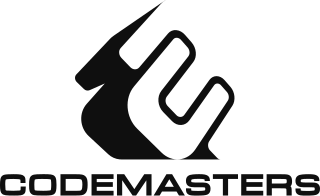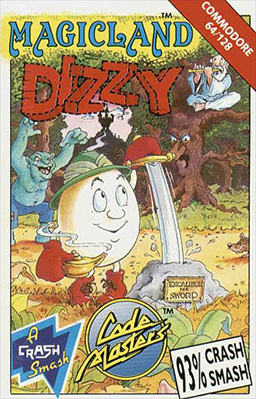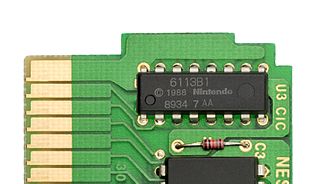
The Aladdin Deck Enhancer is a system-enhancing adaptor to use Compact Cartridges on the Nintendo Entertainment System. It was produced by Camerica and developed by Codemasters but not licensed by Nintendo. It is similar to the Datach system for the Famicom, but without the Barcode feature. It was released in November 1992, with its planned library to reach a total 24 games by the end of 1993. However, only seven games were actually released. The device had low sales and Camerica went bankrupt in 1993.

Treasure Island Dizzy is a puzzle video game published in 1989 by Codemasters for the Amstrad CPC and ZX Spectrum, and later ported to the Commodore 64, NES, Amiga, Atari ST and Atari Jaguar.
Game Genie is a line of video game cheat cartridges originally designed by Codemasters, sold by Camerica and Galoob. The first device in the series was released in 1990 for the Nintendo Entertainment System, with subsequent devices released for the Super NES, Game Boy, Genesis, and Game Gear. All Game Genie devices temporarily modify game data, allowing the player to do things unintended by developers such as, depending on the game, cheating, manipulating various aspects of games, and accessing unused assets and functions. Five million units of the original Game Genie products were sold worldwide, and most video game console emulators for the platforms it was on feature Game Genie code support. Emulators that have Game Genie support also allow a near-unlimited number of codes to be entered whereas the actual products have an upper and lower limit, between three and six codes.

Wisdom Tree, Inc. is an American developer of Christian video games. It was an offshoot of Color Dreams, one of the first companies to work around Nintendo's 10NES lockout chip technology for the Nintendo Entertainment System. Color Dreams formed the Wisdom Tree subsidiary in 1990 in an effort to circumvent Nintendo's restrictions against publishers of unlicensed video games for the NES by selling their games at Christian book stores which was not subject to pressure by Nintendo.
In video gaming, famiclone is a term used to refer to a hardware clone of the Nintendo Entertainment System (NES), known in Japan as the Family Computer or Famicom. They are designed to replicate the workings of, and play games designed for, the NES and Famicom. Hundreds of unauthorized clones and unlicensed game copies have been made available since the height of the NES popularity in the late 1980s. The technology employed in such clones has evolved over the years: while the earliest clones feature a printed circuit board containing custom or third party integrated circuits (ICs), more recent (post-1996) clones utilize single-chip designs, with a custom ASIC which simulates the functionality of the original hardware, and often includes one or more on-board games. Most devices originate in China and Taiwan, and less commonly South Korea. Outside China and Taiwan, they are mostly widespread across emerging markets of developing countries.

The Codemasters Software Company Limited is a British video game developer and former publisher based in Southam, England, which is a subsidiary of American corporation Electronic Arts and managed under EA Sports division. Founded by brothers Richard and David Darling in October 1986, Codemasters is one of the oldest British game studios, and in 2005 was named the best independent video game developer by magazine Develop. It formerly also published third-party games.
Tengen Inc. was an American video game publisher and developer that was created by the arcade game manufacturer Atari Games for publishing computer and console games. It had a Japanese subsidiary named Tengen Ltd..

MiG-29: Soviet Fighter is a shoot 'em up game developed by Codemasters in 1989 and released for several contemporary home computers. An unlicensed version was also released for the Nintendo Entertainment System by Camerica.

Lewis Galoob Toys, Inc., was a toy company headquartered in South San Francisco, California. They are best known for creating Micro Machines, which accounted for 50% of its sales in 1989, and distributing the Game Genie in the United States.

Home Entertainment Suppliers Pty. Ltd. is an Australian company that distributes computer games and gaming equipment. HES' offices are based in Riverwood, Sydney. HES's founder and managing director is Sebastian Giompaolo.

Magicland Dizzy is a platform adventure game published in Europe in 1990 by Codemasters for the ZX Spectrum, Commodore 64 and Amiga platforms. By 1992 there were also MS-DOS, Atari ST and Amstrad CPC versions available. It is the sixth game in the Dizzy series, and the fourth adventure-based Dizzy title. The story, set in a fantasy world called Magicland, follows on from the events of Fantasy World Dizzy, the previous adventure title. In Magicland Dizzy the player controls Dizzy, an egg-shaped character, who is trying to save six of his friends who have been placed under spells by the Evil Wizard Zaks.

The Ultimate Stuntman is a 1990 video game developed by Codemasters and published by Camerica for the Nintendo Entertainment System (NES), featuring action game elements. The Ultimate Stuntman is one of 14 video games published by Camerica for the NES without proper licensing. The company had to create their own cartridges that would bypass Nintendo's lock-out chip and break the 10NES "code". In virtually all of Camerica's games there is a switch found on the reverse side of the cartridge, this allows the user to switch between NTSC and PAL compatibility.

Lewis Galoob Toys, Inc. v. Nintendo of America, Inc. is a 1992 legal case where the United States Court of Appeals for the Ninth Circuit concluded that there was no copyright infringement made by the Game Genie, a video game accessory that could alter the output of games for the Nintendo Entertainment System. The court determined that Galoob's Game Genie did not violate Nintendo's exclusive right to make derivative works of their games, because the Game Genie did not create a new permanent work. The court also found that the alterations produced by the Game Genie qualified as non-commercial fair use, and none of the alterations were supplanting demand for Nintendo's games.

The Nintendo Entertainment System (NES) is an 8-bit home video game console produced by Nintendo. It was first released in Japan on 15 July 1983 as the Family Computer (Famicom). It was then released in American test markets on 18 October 1985 as the redesigned NES, and fully launched in the United States the following year. The NES was distributed in Europe, Australia, and parts of Asia throughout the 1980s under various names. As a third generation console, it mainly competed with Sega's Master System.

The Checking Integrated Circuit (CIC) is a lockout chip designed by Nintendo for the Nintendo Entertainment System (NES) video game console in 1985; the chip is part of a system known as 10NES, in which a key is used by the lock to both check if the game is authentic, and if the game is the same region as the console.
American Game Cartridges (AGC) was an American video game developer and publisher established as a subsidiary of ShareData in 1990. Like ShareData, American Game Cartridges was headquartered in Chandler, Arizona. AGC published three video games for the Nintendo Entertainment System (NES) in 1990.

The Nintendo Entertainment System Game Pak is the software storage medium for the Nintendo Entertainment System, part of the Nintendo's Game Pak series of ROM cartridges.
Lewis Galoob was an American entrepreneur, inventor and the founder of Lewis Galoob Toys.

Micro Machines is a racing game developed by Codemasters and originally published by Camerica for the Nintendo Entertainment System in 1991. Themed around Galoob's Micro Machines toys, players race in miniaturised toy vehicles around various environments. The game is the first installment in the Micro Machines video game series.














